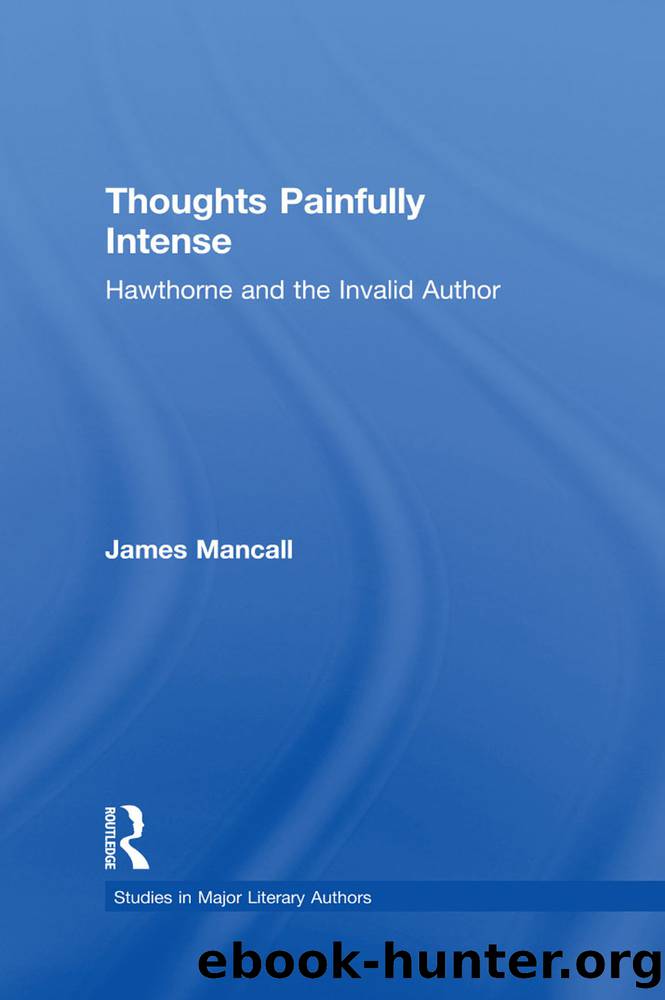Thoughts Painfully Intense by Mancall James;

Author:Mancall, James; [Mancall, James N.]
Language: eng
Format: epub
Publisher: Taylor & Francis Group
Published: 2013-08-15T00:00:00+00:00
But Pearlâs creative work is not safely domestic. It is âwitchcraft,â openly angry and destructive. âShe never created a friend, but seemed always to be sowing broadcast the dragonâs teeth, whence sprung a harvest of armed enemies, against whom she rushed to battleâ (95). This is the romancerâs revenge, openly rushing into battles against his enemiesâthe politicians, the Jack Cades, the slang-whangers. In these moods, we are told, Pearl resembled âan infant pestilence,âthe scarlet fever ⦠whose mission was to punish the sins of the rising generationâ (102â3). Pearl, as âscarlet fever,â like Oberonâs fire, reflects the romancerâs contaminating potential; the desire to spread a pestilence of âpervasive and penetrating mischief,â the desire to create an apocalyptic disorder.
However, even as the text gives expression to these violent urges, it effaces them. By the end of the novel, Pearl gives up her witchcraft and pledges to âgrow up amid human joy and sorrow, nor for ever to do battle with the world, but be a woman in itâ (256). Pearl appears to be cured of her rage; her acts of hostility are effaced by the comfortable conventions of fairy tale: she marries a handsome, wealthy prince. Again, in its portrait of Pearl, the work gestures toward the enactment of violent revenge fantasies, but veers away from them into more publicly acceptable forms of reconciliation.
There are a number of possible motives for this narrative strategy. Pearlâs marriage, as some readers have argued, may be representative of Hawthorneâs own conservatism, his own filiopiety. It may also, as Bercovitch suggests, signal Hawthorneâs desire for consensus rather than conflict. But it is also precisely this kind of self-effacement that allows Hawthorne to conceal an âundertide of filthâ within a âwholesomeâ moral. Pearl is, after all, âthe scarlet letter endowed with life,â and like the novel, her pestilent potential is carefully balanced by a lofty severity and purity. Hawthorneâs private correspondence reflects his split conception of the novel. On the one hand, he found the novel to be, as he told Bridge, âpositively a h-ll-fired story,â once again invoking the figure of the devil in the manuscript (C16:311â12). At the same time, he wrote to James T. Fields that adultery was âa rather delicate subject to write upon, but in the way in which I have treated it, it appears to me there can be no objections on that score.â Hell-fire was carefully balanced by delicacy.
This same duplicity, I would suggest, informs Hesterâs return at the end of the novel. Many readers have argued that Hesterâs role as feminist prophetess is sacrificed for the conventions of domesticity.5 However, I think Hesterâs return at the end of the novel is more complicated. Taking up the scarlet letter, Hester does appear to surrender her revolutionary potential. She still imagines that âa new truth would be revealed, in order to establish the whole relation between man and woman on a surer ground of mutual happiness,â but she will no longer be the prophetess. âThe angel and the apostle of the coming revelation must be a woman, indeed, but lofty, pure, and beautiful; and wiseâ(263).
Download
This site does not store any files on its server. We only index and link to content provided by other sites. Please contact the content providers to delete copyright contents if any and email us, we'll remove relevant links or contents immediately.
4 3 2 1: A Novel by Paul Auster(11788)
The handmaid's tale by Margaret Atwood(7447)
Giovanni's Room by James Baldwin(6808)
Asking the Right Questions: A Guide to Critical Thinking by M. Neil Browne & Stuart M. Keeley(5355)
Big Magic: Creative Living Beyond Fear by Elizabeth Gilbert(5351)
Ego Is the Enemy by Ryan Holiday(4956)
On Writing A Memoir of the Craft by Stephen King(4662)
The Body: A Guide for Occupants by Bill Bryson(4580)
Ken Follett - World without end by Ken Follett(4443)
Bluets by Maggie Nelson(4260)
Adulting by Kelly Williams Brown(4232)
Eat That Frog! by Brian Tracy(4149)
Guilty Pleasures by Laurell K Hamilton(4116)
White Noise - A Novel by Don DeLillo(3829)
The Poetry of Pablo Neruda by Pablo Neruda(3813)
Fingerprints of the Gods by Graham Hancock(3733)
Alive: The Story of the Andes Survivors by Piers Paul Read(3729)
The Book of Joy by Dalai Lama(3695)
The Bookshop by Penelope Fitzgerald(3619)
